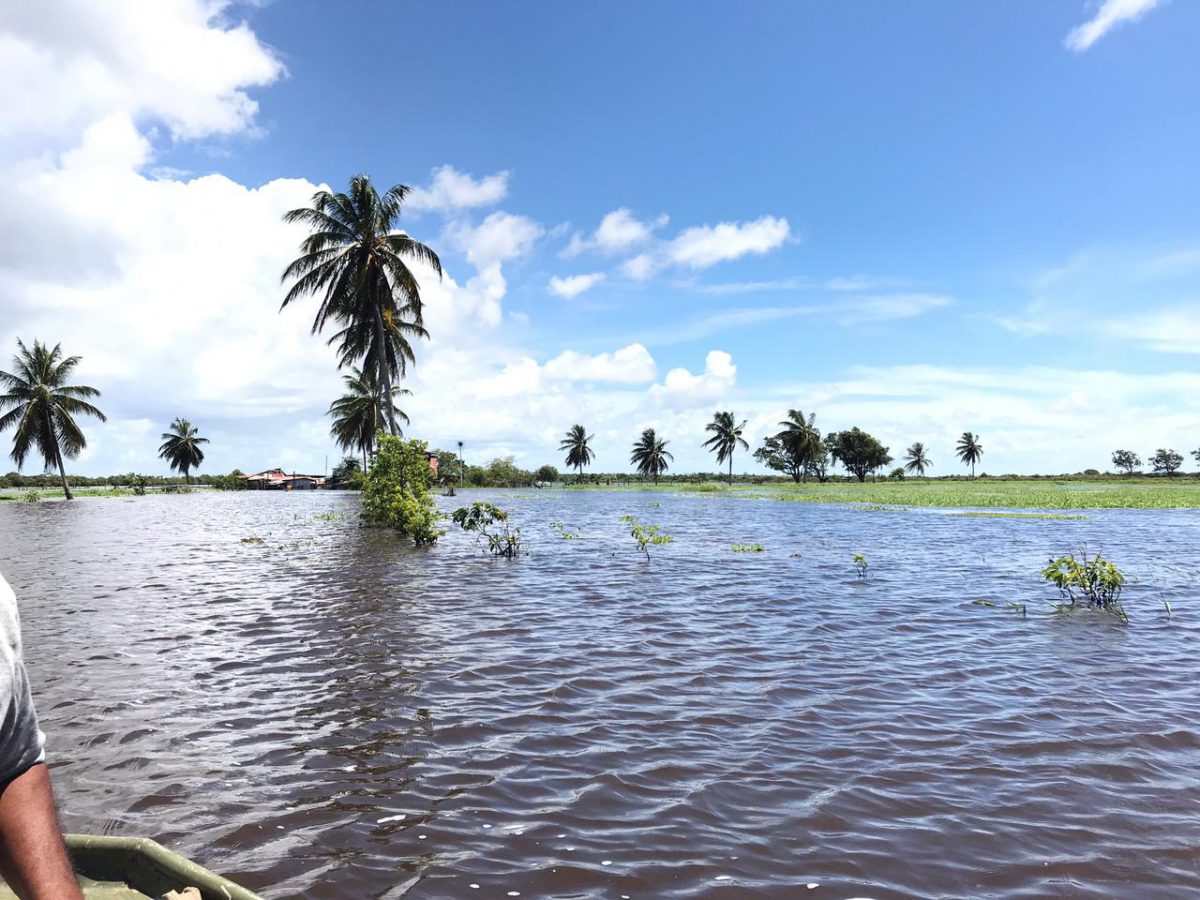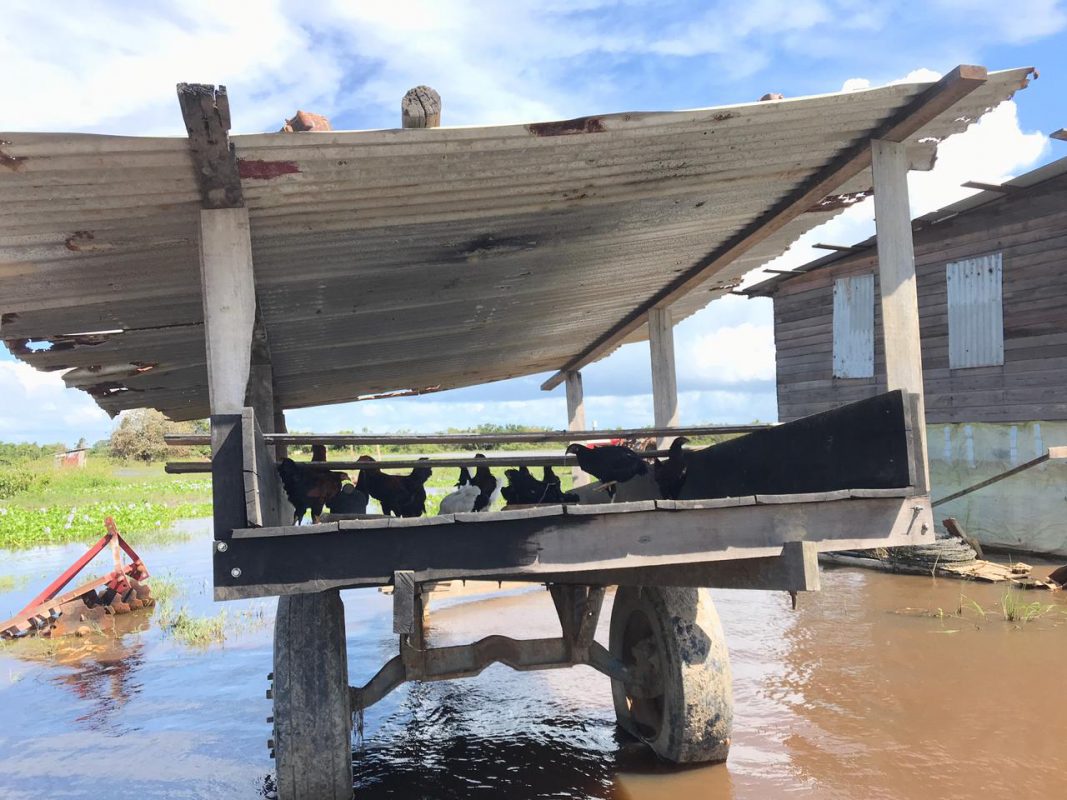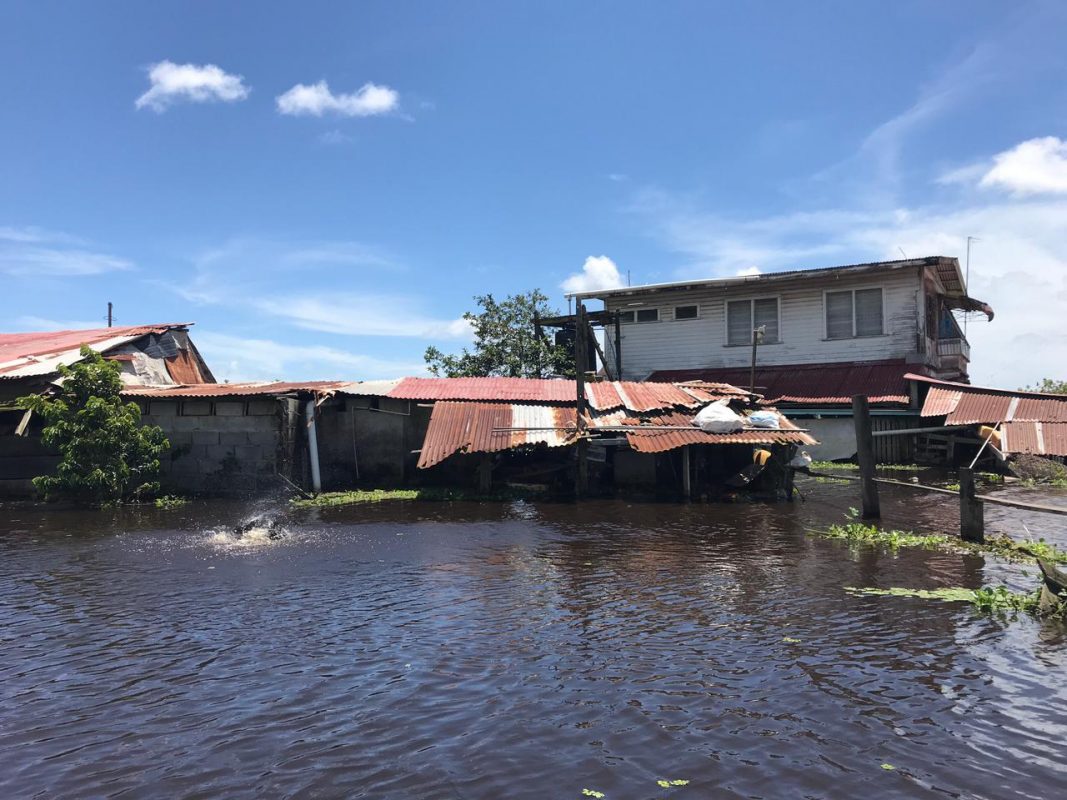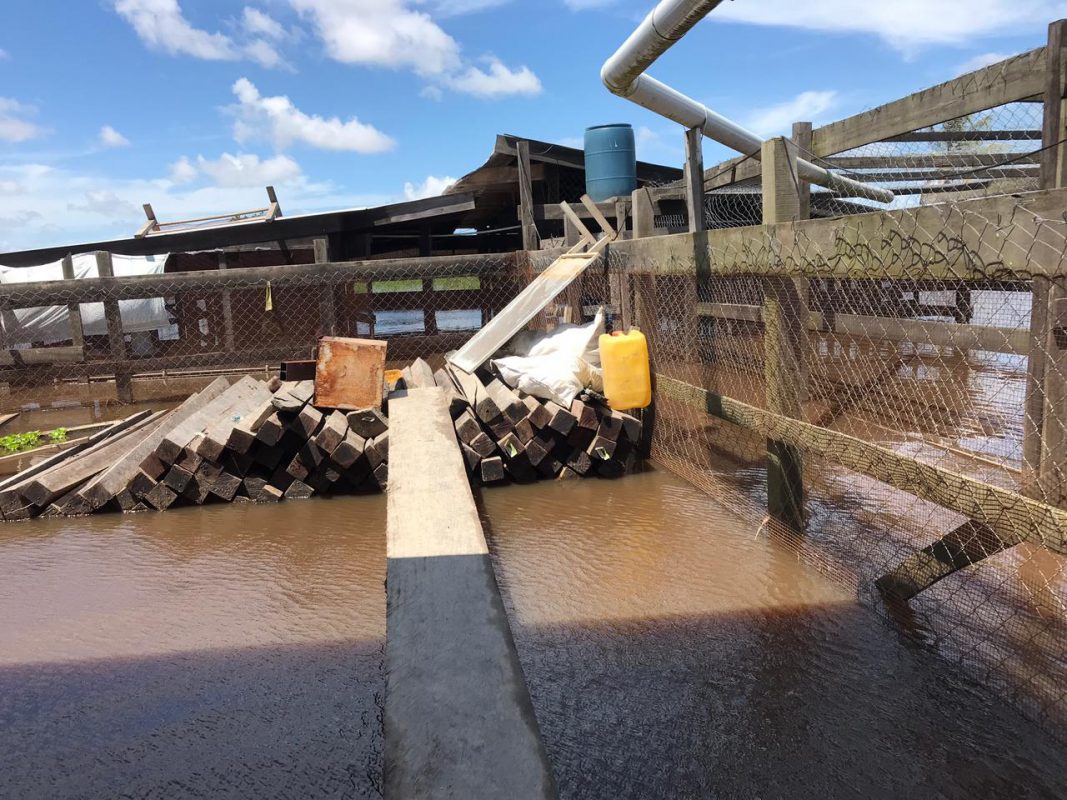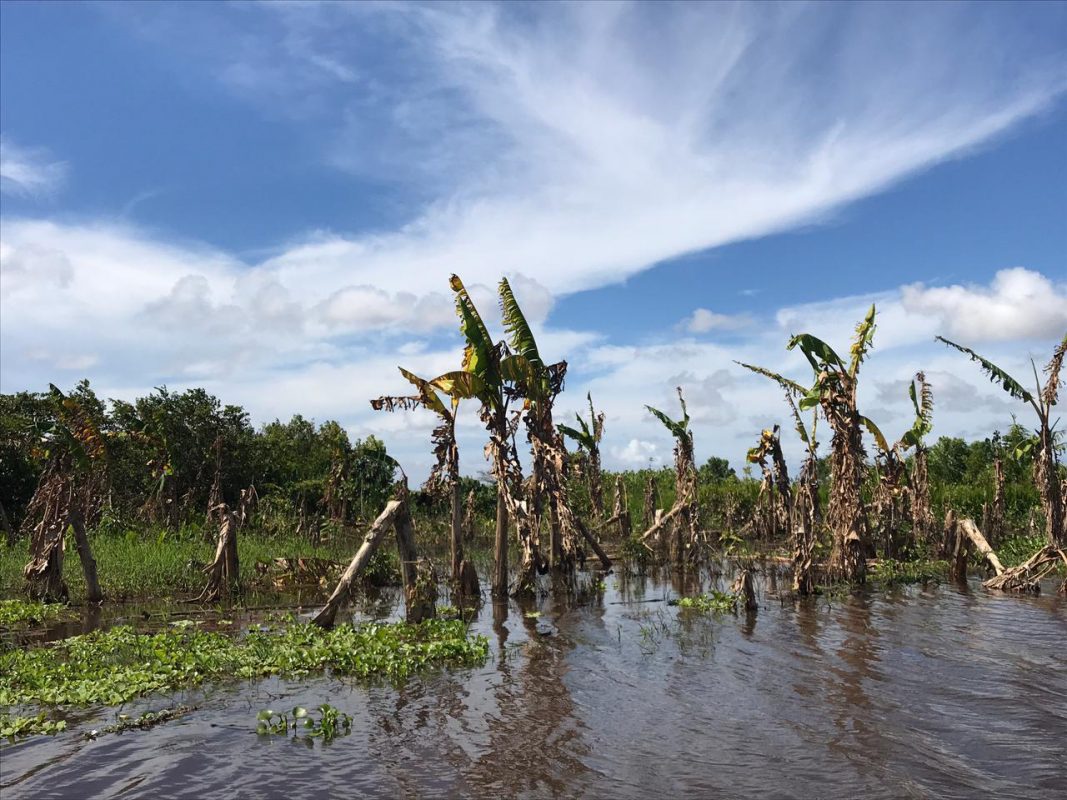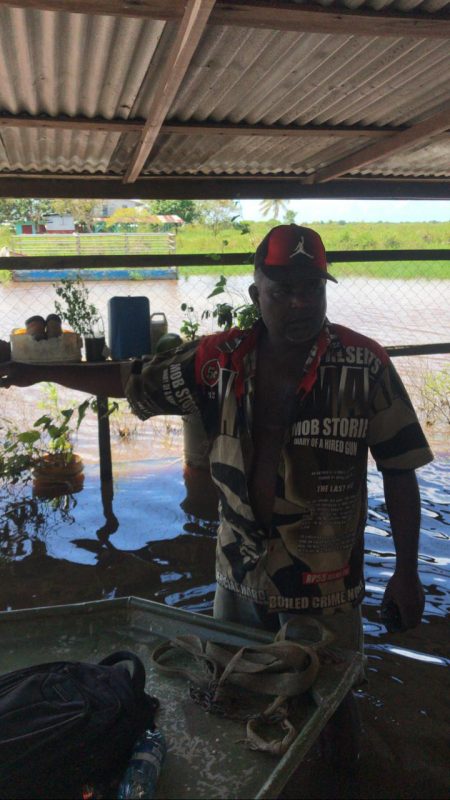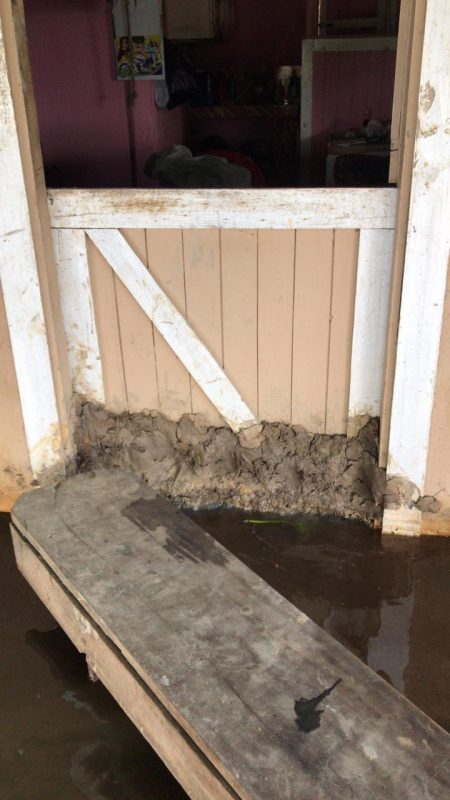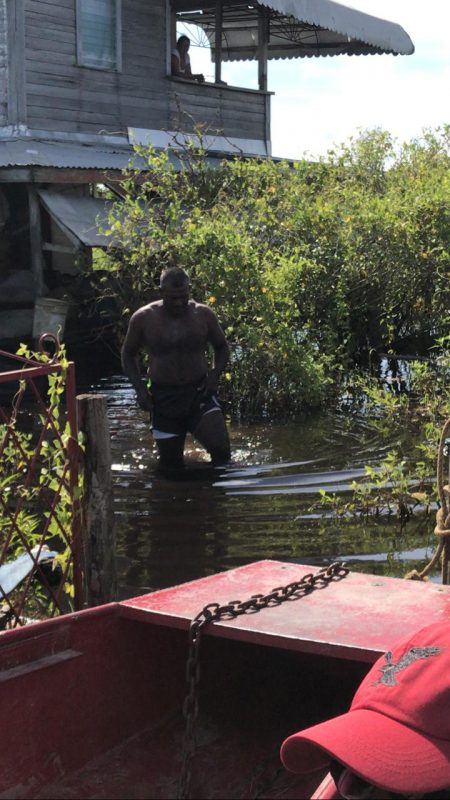As they count their losses from the “worst flooding” in their lifetime, Abary River rice and cattle farmers on Saturday renewed their calls for government to fulfill its promise to desilt and clear overgrown vegetation in the river to improve drainage.
Flooding in the Abary River, in Region Five, has left a trail of devastation for farmers as uncertainty lingers over the state of their livelihoods, with one of their major concerns being access to potable water.
Critics have in the past said that the Abary Creek is heavily silted all the way to its mouth and this reduces its ability to drain into the Atlantic—an opinion that many residents share.
Residents explained that two weeks ago the Regional Democratic Council (RDC) had supplied potable water but they (the residents) were unprepared and were not able to collected sufficient water for their use. Presently, households report that the water collected is just about depleted and they will be grateful if authorities can revisit the area and distribute more.
Rice and cattle farmer Mahase yesterday called for the government to urgently fulfil its promise to clear the mouth of the Abary River.
He pointed out that if the water is removed from land then they will be in a better position to plan for their future. He said that it has been over a month since they were promised excavators and a pontoon to clear the vegetation but nothing has been done since, and every time he attempts to contact the Mahaica, Mahaicony, Abary-Agriculture Development Authority (MMA-ADA), he is unsuccessful.
“They are showing on TV the MMA scheme is in good shape and is ok but that is not the situation… this is the results of the situation. They are asking farmers to work with them but when farmers complain and tell them what to do they don’t listen. When the ministers come here and you say what is the situation, they whisper in his ears is not so and we suffer,” visibly frustrated Mahase said.
He related that in 2008 he was integral in getting the overgrown vegetation cleared after he took then Minister of Agriculture Robert Persaud (whom he said was reluctant to do so) to get a firsthand look at what was happening.
He explained that during the low tides, the water level in the section of the river leading to the Atlantic is low but water levels at the back remain relatively high. This, he said, is as a result of poor drainage and the river being choked.
“I am not asking for handouts. I don’t need handouts! I want this river to clean so we can get some relief from this water. Is bare promises they giving, the minister coming and say one thing but when he gone is a different story. But is over a month they said this pontoon will come here and we still waiting… this thing serious serious, people losing too much and it is not easy – it is pressure for us. This is emergency [and] if you showing you want to help people do it the right way nah…,” the now-angry man declared as he explained that farmers counting more losses with each passing day.
He noted too that during this flood period he even took the Regional Chairman Vickchand Ramphal and Regional Vice Chairman Rion Peters to have a firsthand look at the situation but it remains the same.
With good weather prevailing over the past week, water levels have been slowly dropping, but cattle farmers say in the aftermath they will have to invest in purchasing cattle to replenish their stocks while for rice farmers, at this current state it is likely they will not be able to plant in time for the next crop cycle.
“Is every day we come to the pasture or go to the backdam we see our cattle dead and floating… they have nowhere to go, nowhere dry to stay it… water has been on this land over four weeks and it is not getting any better,” Rictor Ramkishun, a cattle framer lamented yesterday.
‘Nowhere to go’
During a visit by this newspaper to the community yesterday, Ramkishun said that he had stopped venturing into the backdams as it has gotten too depressing for him to see his animals dying. He noted that it has become a challenge also to deal with small-scale rice farmers, who have been threating to hurt any animals who enter into their rice fields.
“These cows have no-where to go and we bring them to the canal road that is dry. They go into the rice field but that is a different problem because the rice farmers tell you is only $2000 [the cost of pesticides] to solve their problems,” he bemoaned.
Other farmers shared similar stories, with one farmer sharing that she was served with a letter from a rice farmer through his lawyer claiming $2.5 million in damages.
“We just fed up of this situation because it is becoming very hard for us. We have nowhere for our cows to go and soon as they graze on this over [the dry section] the rice farmers call you and complain. Three o’ clock in the morning all, they call you to complain and sometimes it is not your cow but they don’t believe you… we don’t know what we will have remaining at the end of this flooding,” farmer Meenawattie Chitanajoran stated.
Several farmers also related that they have been forced to put their animals on higher ground and bring them feed in a bid to save them from starvation.
At least two farmers were observed cutting grass and other vegetation from the river banks and shuttling it to their animals.
“Before it get this bad and the cows weren’t dying so much, we used to cut the grass put it in the boat and take it to the cows, but now you can’t stand the scent so we bring the cows to the grass. Especially the calves,” a livestock farmer Mukesh Chatrua explained.
When Stabroek News visited the community yesterday, Chatrua was observed feeding a calf on the stairs of his home.
“This is what we have to do now. They have no dry place to go so we have to bring them here. Every day we go backdam we seeing dead calves, dead cows, and your heart break because we can’t help them… another thing the cows are aborting their calf or when the calves born in the water they drown so there is little help we can offer them,” he lamented.
The cattle farmers highlighted the need for higher grounds and while acknowledging that land was offered at Letter T for farmers to store their herd, said they haven’t taken up the offer due to security concerns.
“At Letter T, there is 25,000 acres of land and GLDA [Guyana Livestock Development Authority] offered for us to use it but we still cannot protect our cows from thieves. Who have the power to watchman 25,000 acres 24 hours a day? It is not a bad idea but they have a lot of thieves around,” a farmer pointed out.
Rohan Oodit, owner of M&B Construction, has since made over 500 acres of his land at Letter T, Mahaicony, and Zorg-en-Hoop, Blairmont, available to the government for cattle farmers who are in need to relocate their animals.
Additionally, Ramkishun opined that although the left bank of Abary is designated for cattle rearing it appears as if government has no interest in providing assistance to them.
“The rice farmers getting all the help… they getting two three machines to use to help them save their rice but we is like nothing we don’t get any help. They give us some bran and that is it but look water here and they are not doing anything to help us…,” he complained.
Farmers indicated that even areas not permitted for rice cultivation have been utilized, leaving them without any option to graze their cows at this time.
The farmer, who also cultivates cash crops, lamented that he was unable to save anything and with the water remaining on land for this long, the trees too are dying.
Millions lost
When the flood hit, several farmers were unable to harvest and as a result suffered tremendous losses. Ramesh Ally, a medium-scale farmer who plants 250 acres of rice, has lost close to $13 million.
“We barely get to cut rice. I managed to get three grain carts and then the floods come without any warning. I don’t know how long this water will stay on land but it’s here almost five weeks and we can’t do anything. I have debts because I only buy a combine last crop and I have to keep paying flood or no flood,” he stated.
Gangaram Prashad, a manager of S Kissoon Ranch, related that they were able to save some of their 400 acres of rice but it cost them a lot as they had to not only invest in additional fuel to drain water from the land but also hire excavators to empolder the rice fields to reduce the amount of water getting in.
He said that during the regular crop season they are able to harvest 10,000 bags of paddy but with the flooding this year they were only successful in harvesting half that amount.
Additionally, he said they have lost dozens of cows and while they try to save a few it is difficult as the situation keeps getting worse.
And another farmer, Billy, said the situation is frustrating as they keep counting losses daily. He said he has lost almost $2 million in investments for this rice crop as the floods hit when the rice was only 17 days old. In addition to the $2 million, he has had to spend extra money on fuel to pump water out but was unsuccessful in saving anything as the water levels kept rising.
“Look what is happening here, water all over… we have been under water for weeks and we haven’t seen ministers coming to see what is happening. It is like people in Abary don’t get affected by flooding… is bare pigs living here…,” the exasperated farmer said.
He stated that the flood waters came up forcefully and like other farmers he is convinced it is water released from the conservancy and rain water that has led to the flooding.
Permanent crop farmer, Jeremy Sharma also related that the water came forcefully and sat on the land.
A visit to his plantain and banana farm showed that everything has died and he estimates his losses to be close to a $1 million.
“I cannot save anything. Well, there is nothing to save. Starting back will be very hard it is going to take at least three years before we are able to reap anything after we plant back. In the meantime, I will have to look at cash crop and poultry but as of now everything is gone,” he remarked.
As if the threat of flooding is not enough, farmers yesterday told Stabroek News that wildlife is posing a new threat to them as not only are their yards frequented by snakes but recently they have seen jaguars roaming in both the pastures and housing areas. “We don’t know where they are coming from but they are here. A day one was in coconut tree and we have seen the cows having bite marks on their necks. We don’t know if the cows dying are bringing them out or what,” a farmer wondered.
